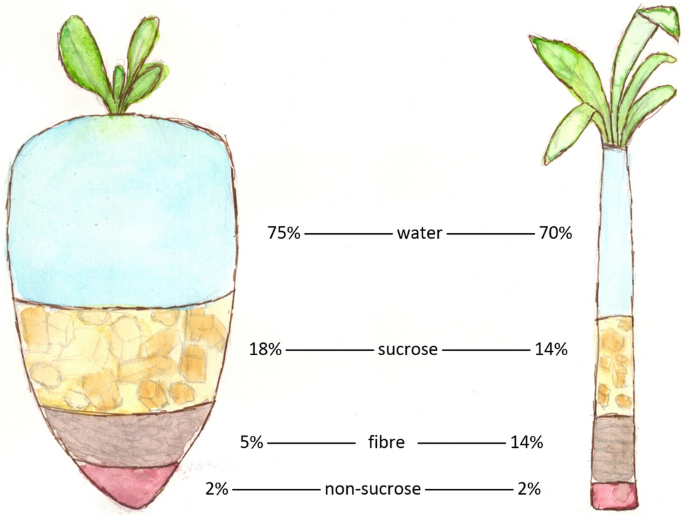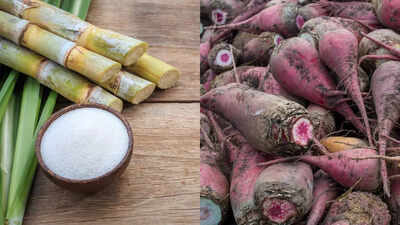A checklist for understanding Sugar beet vs sugar cane differences
Unveiling the Fact Behind Sugar Beet Vs Sugar Cane: Benefits, Makes Use Of, and Handling Techniques Described
The distinction between sugar beet and sugar cane is typically forgotten in conversations regarding sugar manufacturing. Each plant offers special advantages and applications in various markets. Their growing methods and processing techniques likewise vary especially. Understanding these subtleties is vital for stakeholders in the sugar market. What ramifications do these distinctions have for health and wellness, flavor, and ecological influence? Checking out these facets can disclose deeper understandings right into the global sugar market.

Summary of Sugar Beet and Sugar Cane
Sugar beet and sugar cane are two key resources of sugar, each with distinctive qualities and farming methods. Sugar beet, a root veggie, grows in warm climates and is normally gathered in the autumn. Its high sugar content, varying from 15% to 20%, makes it a valuable plant for sugar production. The procedure involves removing juice from the beets, which is then improved into granulated sugar.
In comparison, sugar cane is an exotic lawn that flourishes in cozy, humid environments. It can attain a sugar material of as much as 14%, yet its high, fibrous stalks need comprehensive processing. The cane is squashed to draw out juice, which undergoes boiling and crystallization to produce sugar. Both sources contribute greatly to the international sugar supply, with sugar beet generally cultivated in Europe and North America, while sugar cane is primarily expanded in Brazil, India, and various other tropical regions.
Farming Practices: Sugar Beet vs. Sugar Cane
Cultivation techniques for sugar beet and sugar cane vary substantially as a result of their unique expanding conditions. Sugar beetroots grow in cooler environments with well-drained soil, while sugar cane favors warmer temperature levels and bountiful dampness. Additionally, the harvesting techniques used for each plant mirror these ecological requirements and affect general return and quality.
Expanding Problems Comparison
While both sugar beet and sugar cane prosper in particular ecological problems, their farming techniques vary substantially. Sugar beet is mostly expanded in warm areas, preferring cooler environments with well-drained dirt and moderate rains. It needs a growing period of concerning 90 to 120 days, with suitable temperature levels between 15 ° C to 25 ° C. On the other hand, sugar cane embellishments in tropical and subtropical climates, thriving in warm temperature levels ranging from 20 ° C to 32 ° C. It requires plentiful sunlight and constant rains, frequently needing watering in drier areas. Sugar cane has a much longer growing cycle, generally lasting 12 to 24 months. These differences in growing conditions considerably affect the geographical distribution and agricultural methods associated with each plant.
Collecting Techniques Differences
The harvesting techniques for sugar beet and sugar cane reflect their unique growth attributes and farming methods. Sugar beet is usually harvested mechanically, with harvesters developed to uproot the entire plant, making certain minimal soil disturbance. The beetroots are after that transferred for handling quickly after harvest to maintain high quality. In comparison, sugar cane harvesting commonly involves a combination of manual and mechanical approaches. Employees may initially cut the cane by hand, particularly in regions where automation is much less practical. Ultimately, specialized equipment is utilized to collect and transfer the cut stalks to processing facilities. These varying strategies not just impact performance however also affect the top quality and return of the final sugar items, showcasing the flexibility of each plant to its atmosphere.
Nutritional Contrast and Health And Wellness Perks
When contrasting the nutritional profiles of sugar beet and sugar cane, it comes to be clear that each offers unique health advantages. Sugar beetroots are rich in necessary nutrients like folate, manganese, and potassium, which add to overall wellness. They also have fiber, which assists food digestion and may aid control blood sugar degrees. Furthermore, sugar beets are known for their antioxidant residential or commercial properties, which can battle oxidative stress and anxiety.
Conversely, sugar cane is primarily made up of sucrose, giving fast power. While it lacks the exact same degree of minerals and vitamins found in sugar beetroots, sugar cane does consist of small amounts of B nutrients such as calcium and magnesium. Sugar cane juice is usually promoted for its hydrating buildings Resources and potential health and wellness benefits, including improved digestion wellness. Eventually, the option between sugar beet and sugar cane might rely on individual health objectives and dietary preferences.
Taste Accounts and Culinary Makes Use Of
Flavor profiles of sugar beet and sugar cane differ substantially, influencing their culinary applications (Sugar beet vs sugar cane). Sugar cane, with its naturally sweet and complex flavor, is typically favored in beverages, treats, and numerous cooking meals. It lends a rich, caramel-like note that enhances the preference of products such as syrups, molasses, and rum. In contrast, sugar beet has a more neutral and less aromatic preference, making it appropriate for applications where sweetness is desired without altering the dish's inherent tastes. It is regularly made use of in processed foods, baked items, and sugar
Cooking professionals commonly pick sugar cane for its deepness and richness, especially in exquisite read this post here food preparation and craft beverages. Alternatively, sugar beet's versatility as a sugar in mass-produced products accommodates a more comprehensive market. Eventually, the choice in between these two sugars can greatly influence flavor profiles and general culinary experiences.
Ecological Impact of Sugar Manufacturing
Sugar production, whether from sugar beet or sugar cane, carries significant ecological implications. Sugar cane growing frequently results in deforestation, specifically in exotic regions, disrupting local ecosystems and contributing to biodiversity loss. The substantial use of plant foods and chemicals in both sugar beet and sugar cane farming can lead to soil destruction and water air pollution, affecting surrounding environments and communities. Additionally, the high water usage required for sugar cane irrigation postures a danger to local water supplies, specifically in dry regions.
On the other hand, sugar beet farming normally occurs in warm environments, which might mitigate some deforestation concerns. It is not without its very own challenges, including dirt erosion and dependence on chemical inputs. Generally, the ecological impact of sugar production is multifaceted, necessitating sustainable farming practices and recognition of resource monitoring to lessen damages to ecosystems and promote environmental wellness.
Processing Techniques: From Plant to Sugar
Various handling strategies are used to transform sugar beet and sugar cane right into granulated sugar, each technique reflecting the unique features of the source plant. For sugar beets, the process begins with cleaning and cutting the origins into slim strips, which are after that based on diffusion-- a technique where warm water extracts sugar from the beet slices. The resulting liquid is detoxified, concentrated, and taken shape.
On the other hand, sugar cane handling involves crushing the stalks to extract juice, adhered to by information to get rid of impurities. The juice is then vaporized, causing syrup that goes through condensation. Both procedures are followed by separation of the sugar crystals from the molasses, which is a by-product. The final stages include drying out and packaging the granulated sugar for distribution. These methods highlight the distinct paths via which these additional hints 2 plants produce sugar, each with its own set of difficulties and efficiencies.
Economic Elements of Sugar Beet and Sugar Cane Industries
The financial landscape of the sugar beet and sugar cane industries reveals noteworthy differences in manufacturing costs, market characteristics, and regional influences. Sugar beet, mostly grown in temperate climates, usually incurs higher manufacturing prices due to labor and input costs. Conversely, sugar cane prospers in tropical areas, normally taking advantage of lower labor costs and favorable weather conditions, which can lead to greater yields.
Market characteristics additionally differ, as sugar cane dominates worldwide manufacturing, accounting for about 80% of sugar output. This prevalence affects rates frameworks and trade circulations. On the other hand, sugar beet is much more regionally focused, especially in Europe and North America, influencing local economies based on beet production.
Furthermore, variations in worldwide sugar costs can significantly affect both markets, influencing farmer earnings and investment degrees. Comprehending these financial aspects is essential for stakeholders intending to browse the complexities of the sugar market efficiently.

Often Asked Questions

Can Sugar Beet and Sugar Cane Be Intercropped Successfully?
Intercropping sugar beet and sugar cane offers difficulties as a result of differing development needs and ecological requirements. With cautious administration and suitable conditions, it may yield advantages such as boosted soil health and wellness and source efficiency.

What Are the Historical Origins of Sugar Beet and Sugar Cane?
The historical beginnings of sugar beet trace back to 18th century Europe, while sugar cane has origins in Southeast Asia, grown for thousands of years. Both plants have substantially influenced worldwide sugar production and agriculture.
Just How Do Sugar Beet and Sugar Cane Affect Dirt Health And Wellness?
The results of sugar beet and sugar cane on dirt wellness differ. Sugar beet can enhance soil structure and nutrient web content, while sugar cane might deplete nutrients if not taken care of correctly, affecting lasting dirt fertility.
Exist Any Arising Technologies in Sugar Production?
Emerging modern technologies in sugar production include accuracy farming, progressed genetic modification for greater yields, and ingenious extraction methods. These innovations intend to improve performance, decrease ecological impact, and improve the total sustainability of sugar production processes.
What Are the Key Differences in Labor Requirements for Both Plants?
The essential distinctions in labor needs for sugar beet and sugar cane hinge on growing, harvesting, and handling. Sugar beet vs sugar cane. Sugar beet usually requires even more automation, while sugar cane frequently requires extra manual work for harvesting and processing stages